ABS HYUNDAI I20 2022 Owners Manual
[x] Cancel search | Manufacturer: HYUNDAI, Model Year: 2022, Model line: I20, Model: HYUNDAI I20 2022Pages: 444, PDF Size: 8.93 MB
Page 51 of 444

4-18
Safety system
WARNING
Improperly positioned seat belts may
increase the risk of serious injury
in an accident.Take the following
precautions when adjusting the seat
belt:
• Position the lap portion of the seat
belt as low as possible across your
hips, not on your waist, so that it
fits snugly.This allows your strong
pelvic bones to absorb the force of
the crash, reducing the chance of
internal injuries.
• Position one arm under the shoulder
belt and the other over the belt, as
shown in the illustration.
• Always position the shoulder belt
anchor into the locked position at the
appropriate height.
• Never position the shoulder belt
across your neck or face.
OHSS038102OHSS038102
WARNING
You should place the lap belt portion
as low as possible and snugly across
your hips, not on your waist. If the lap
belt is located too high on your waist, it
may increase the chance of injury in the
event of a collision. Both arms should
not be under or over the belt. Rather,
one should be over and the other
under, as shown in the illustration.
Never wear the seat belt under the arm
nearest the door.
Page 84 of 444

4-51
04
WARNING
• Do not hit or allow any objects to
impact the locations where air bags
or sensors are installed.
This may cause unexpected air bag
deployment, which could result in
serious personal injury or death.
• If the installation location or angle
of the sensors is altered in any way,
the air bags may deploy when they
should not or they may not deploy
when they should, causing severe
injury or death.
Therefore, do not try to perform
maintenance on or around the air
bag sensors. We recommend that the
system be serviced by an authorized
HYUNDAI dealer.
• Problems may arise if the sensor
installation angles are changed
due to the deformation of the front
bumper and body. We recommend
that the system be serviced by an
authorized HYUNDAI dealer.
• Your vehicle has been designed to
absorb impact and deploy the air
bag(s) in certain collisions. Installing
aftermarket bumper guards or
replacing a bumper with non-
genuine parts may adversely affect
your vehicles collision and air bag
deployment performance.
Air bag inflation conditions
OBC3030027OBC3030027
Front air bags
Front air bags are designed to inflate in
certain frontal collision depending on
the crash severity, speed or angles of
impact of the front collision.
If the vehicle chassis is impacted by
bumps or objects on unimproved roads
or sidewalks, air bags may deploy.
Drive carefully on unimproved roads
or on surfaces not designed for vehicle
traffic to prevent unintended air bag
deployment.
Page 87 of 444
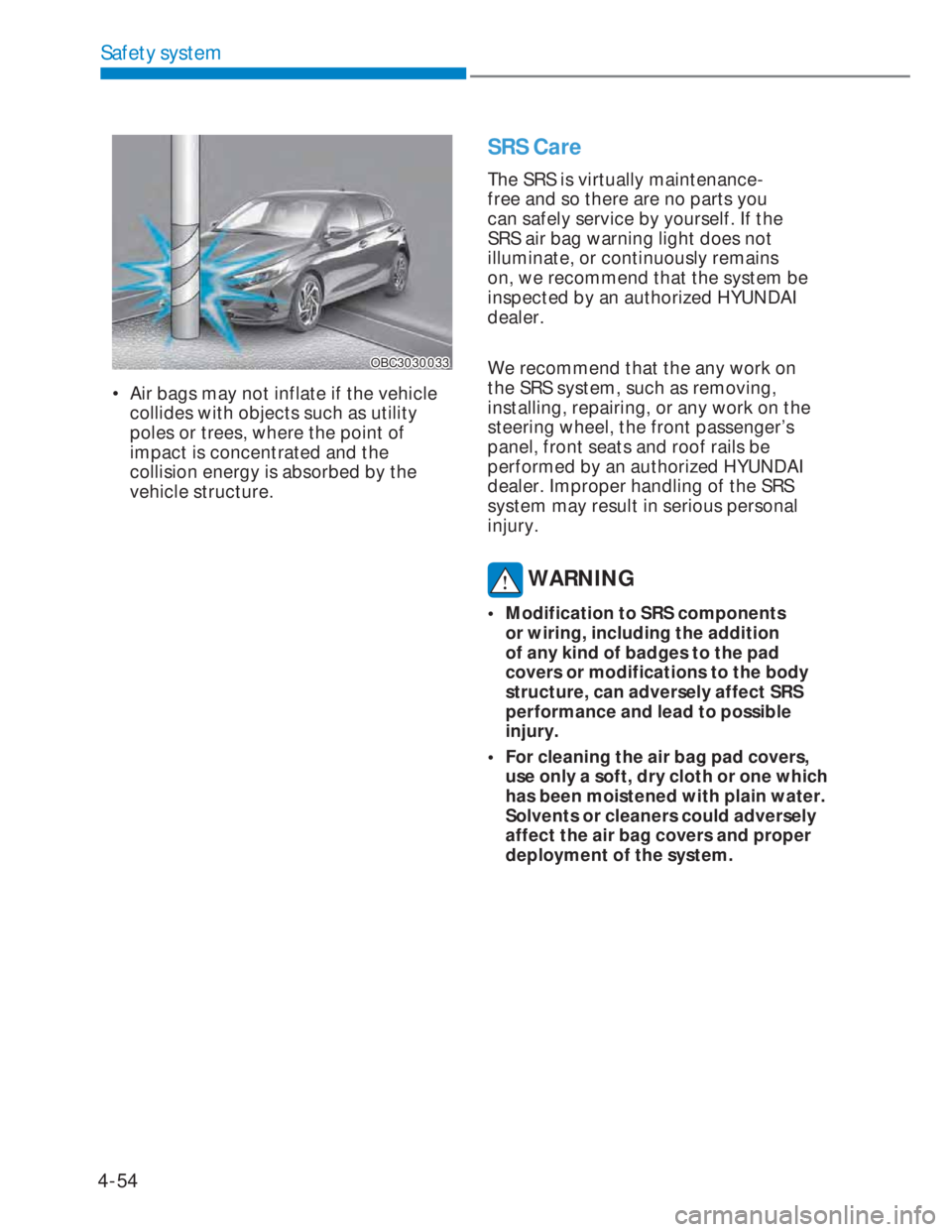
4-54
Safety system
OBC3030033OBC3030033
• Air bags may not inflate if the vehicle
collides with objects such as utility
poles or trees, where the point of
impact is concentrated and the
collision energy is absorbed by the
vehicle structure.
SRS Care
The SRS is virtually maintenance-
free and so there are no parts you
can safely service by yourself. If the
SRS air bag warning light does not
illuminate, or continuously remains
on, we recommend that the system be
inspected by an authorized HYUNDAI
dealer.
We recommend that the any work on
the SRS system, such as removing,
installing, repairing, or any work on the
steering wheel, the front passenger’s
panel, front seats and roof rails be
performed by an authorized HYUNDAI
dealer. Improper handling of the SRS
system may result in serious personal
injury.
WARNING
• Modification to SRS components
or wiring, including the addition
of any kind of badges to the pad
covers or modifications to the body
structure, can adversely affect SRS
performance and lead to possible
injury.
• For cleaning the air bag pad covers,
use only a soft, dry cloth or one which
has been moistened with plain water.
Solvents or cleaners could adversely
affect the air bag covers and proper
deployment of the system.
Page 100 of 444
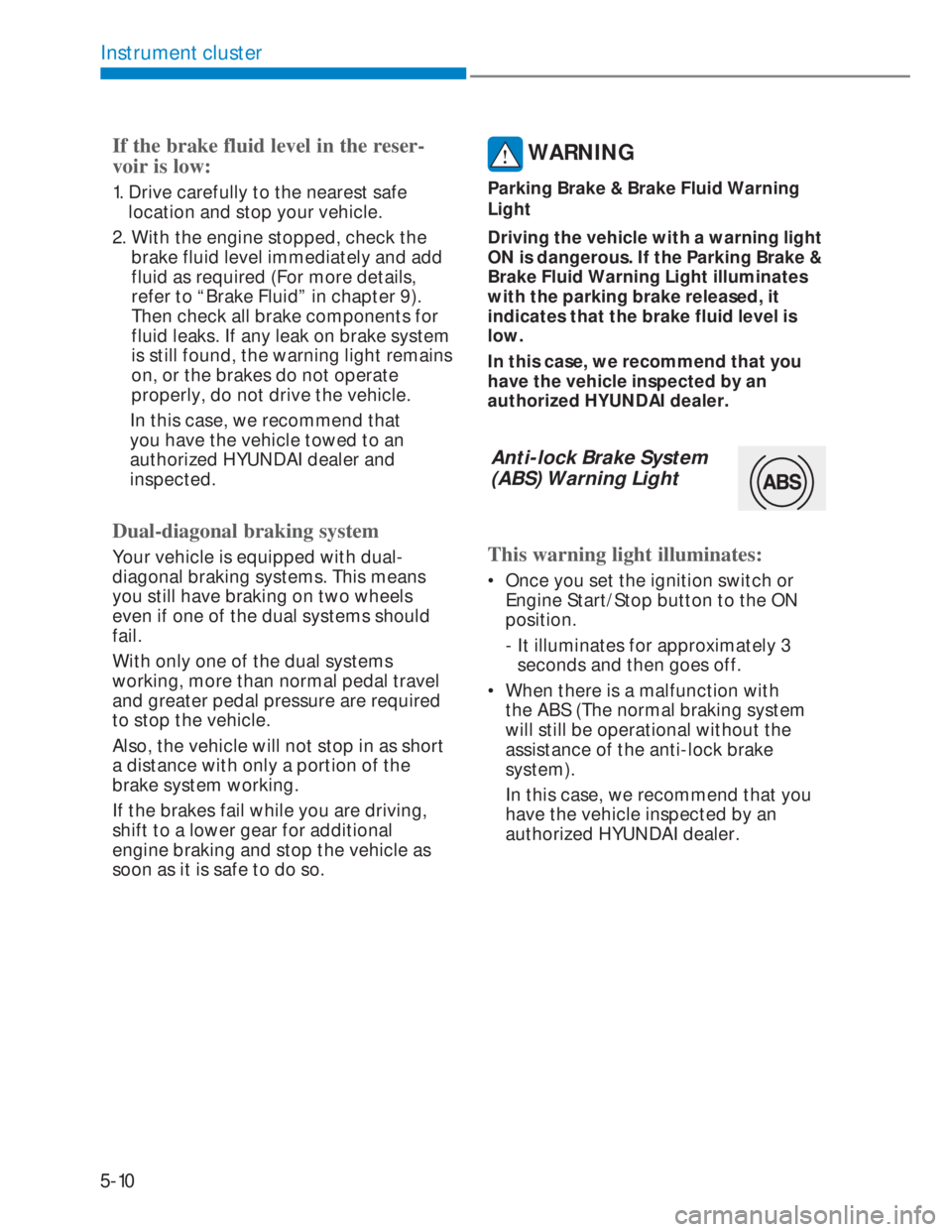
5-10
Instrument cluster
If the brake fluid level in the reser-
voir is low:
1. Drive carefully to the nearest safe
location and stop your vehicle.
2. With the engine stopped, check the
brake fluid level immediately and add
fluid as required (For more details,
refer to “Brake Fluid” in chapter 9).
Then check all brake components for
fluid leaks. If any leak on brake system
is still found, the warning light remains
on, or the brakes do not operate
properly, do not drive the vehicle.
In this case, we recommend that
you have the vehicle towed to an
authorized HYUNDAI dealer and
inspected.
Dual-diagonal braking system
Your vehicle is equipped with dual-
diagonal braking systems. This means
you still have braking on two wheels
even if one of the dual systems should
fail.
With only one of the dual systems
working, more than normal pedal travel
and greater pedal pressure are required
to stop the vehicle.
Also, the vehicle will not stop in as short
a distance with only a portion of the
brake system working.
If the brakes fail while you are driving,
shift to a lower gear for additional
engine braking and stop the vehicle as
soon as it is safe to do so.
WARNING
Parking Brake & Brake Fluid Warning
Light
Driving the vehicle with a warning light
ON is dangerous. If the Parking Brake &
Brake Fluid Warning Light illuminates
with the parking brake released, it
indicates that the brake fluid level is
low.
In this case, we recommend that you
have the vehicle inspected by an
authorized HYUNDAI dealer.
Anti-lock Brake System
(ABS) Warning Light
This warning light illuminates:
• Once you set the ignition switch or
Engine Start/Stop button to the ON
position.
- It illuminates for approximately 3
seconds and then goes off.
• When there is a malfunction with
the ABS (The normal braking system
will still be operational without the
assistance of the anti-lock brake
system).
In this case, we recommend that you
have the vehicle inspected by an
authorized HYUNDAI dealer.
Page 248 of 444
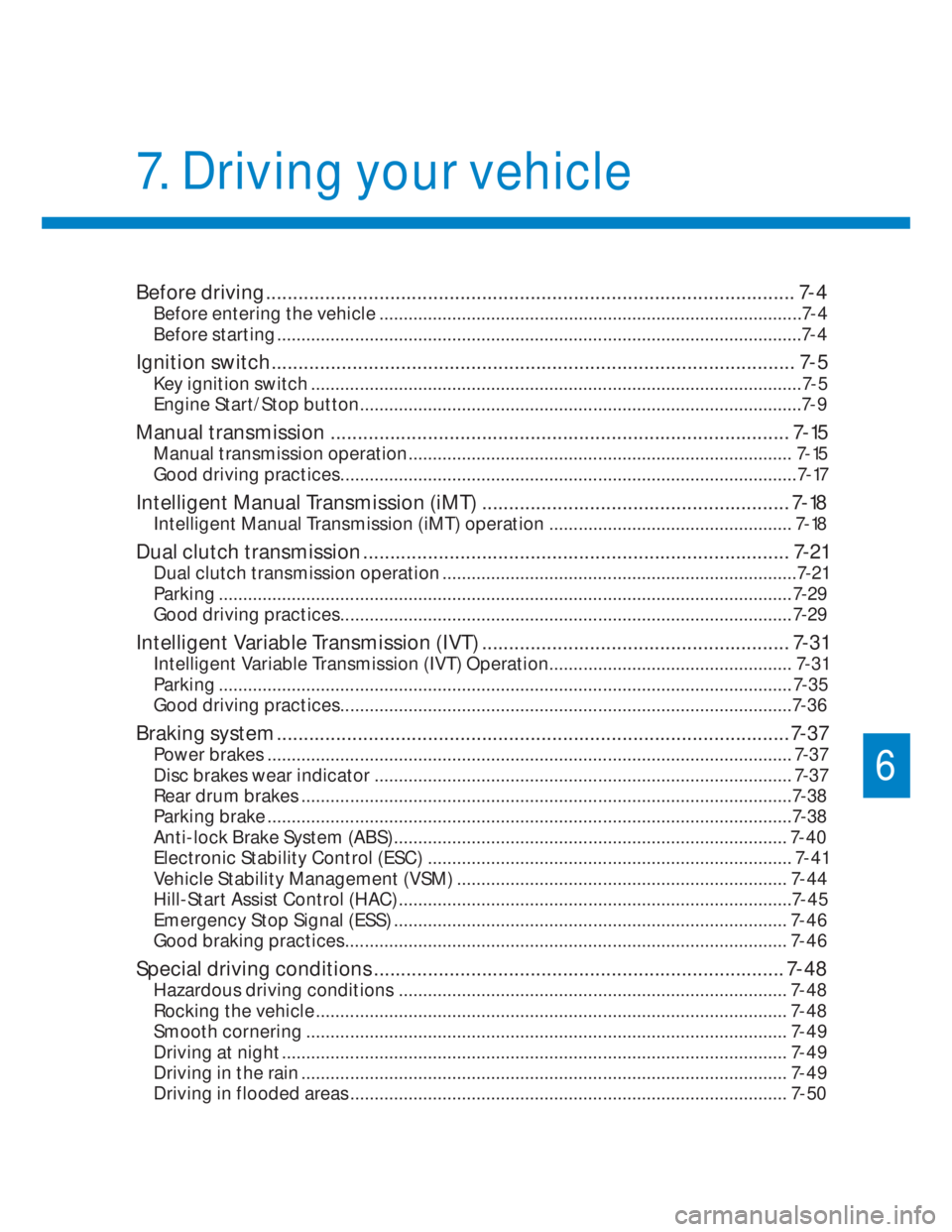
Before driving .................................................................................................. 7-4
Before entering the vehicle .......................................................................................7-4
Before starting ............................................................................................................7-4
Ignition switch ................................................................................................. 7-5
Key ignition switch .....................................................................................................7-5
Engine Start/Stop button
...........................................................................................7-9
Manual transmission ..................................................................................... 7-15
Manual transmission operation ............................................................................... 7-15
Good driving practices
..............................................................................................7-17
Intelligent Manual Transmission (iMT) ......................................................... 7-18
Intelligent Manual Transmission (iMT) operation .................................................. 7-18
Dual clutch transmission ............................................................................... 7-21
Dual clutch transmission operation .........................................................................7-21
Parking ......................................................................................................................7-29
Good driving practices .............................................................................................7-29
Intelligent Variable Transmission (IVT) ......................................................... 7-31
Intelligent Variable Transmission (IVT) Operation .................................................. 7-31
Parking ...................................................................................................................... 7-35
Good driving practices .............................................................................................7-36
Braking system ............................................................................................... 7-37
Power brakes ............................................................................................................ 7-37
Disc brakes wear indicator ...................................................................................... 7-37
Rear drum brakes .....................................................................................................7-38
Parking brake
............................................................................................................7-38
Anti-lock Brake System (ABS) ................................................................................. 7-40
Electronic Stability Control (ESC) ........................................................................... 7-41
Vehicle Stability Management (VSM) .................................................................... 7-44
Hill-Start Assist Control (HAC)
.................................................................................7-45
Emergency Stop Signal (ESS) ................................................................................. 7-46
Good braking practices ........................................................................................... 7-46
Special driving conditions ............................................................................ 7-48
Hazardous driving conditions ................................................................................ 7-48
Rocking the vehicle ................................................................................................. 7-48
Smooth cornering ................................................................................................... 7-49
Driving at night ........................................................................................................ 7-49
Driving in the rain
.................................................................................................... 7-49
Driving in flooded areas .......................................................................................... 7-50
7. Driving your vehicle
6
Page 287 of 444
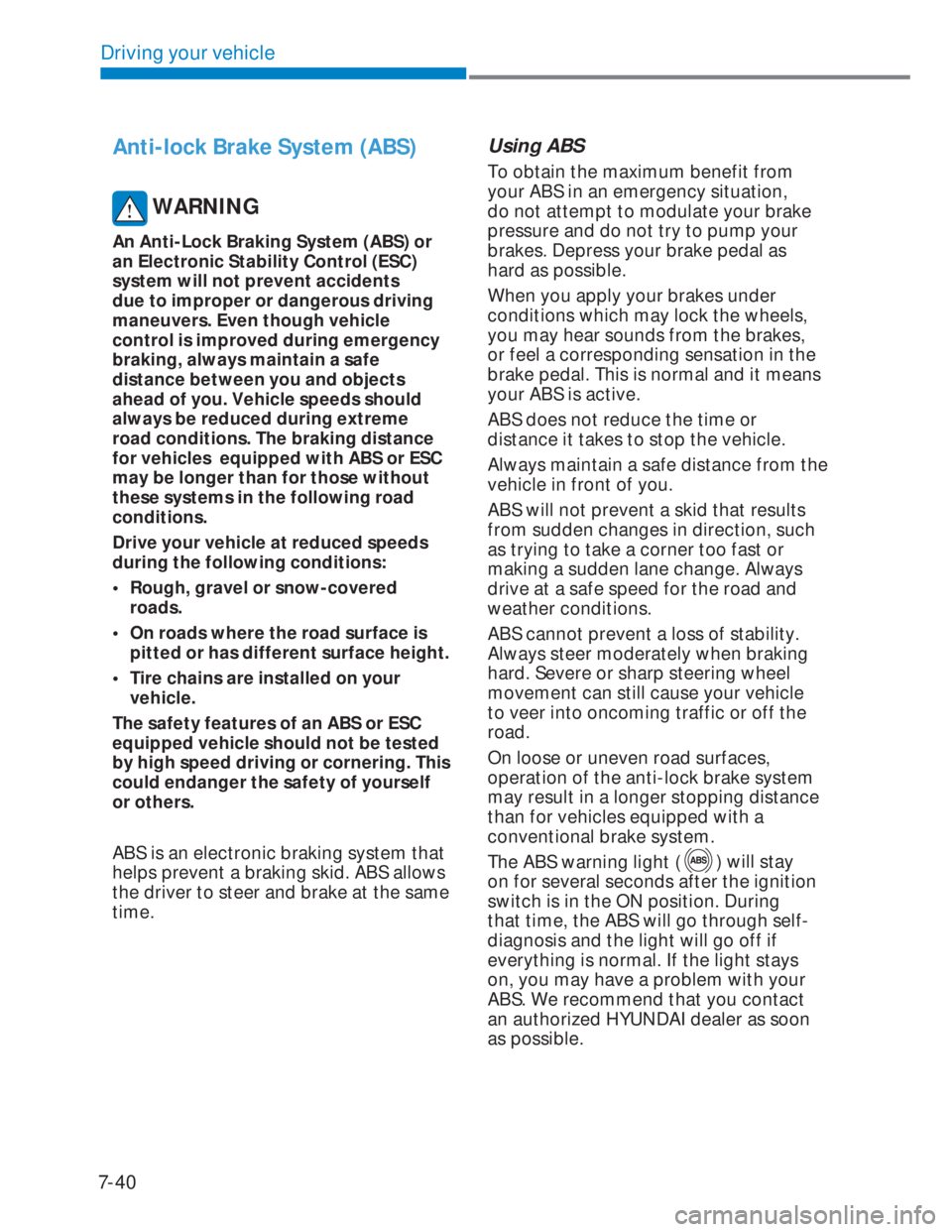
7-40
Driving your vehicle
Anti-lock Brake System (ABS)
WARNING
An Anti-Lock Braking System (ABS) or
an Electronic Stability Control (ESC)
system will not prevent accidents
due to improper or dangerous driving
maneuvers. Even though vehicle
control is improved during emergency
braking, always maintain a safe
distance between you and objects
ahead of you. Vehicle speeds should
always be reduced during extreme
road conditions. The braking distance
for vehicles equipped with ABS or ESC
may be longer than for those without
these systems in the following road
conditions.
Drive your vehicle at reduced speeds
during the following conditions:
• Rough, gravel or snow-covered
roads.
• On roads where the road surface is
pitted or has different surface height.
• Tire chains are installed on your
vehicle.
The safety features of an ABS or ESC
equipped vehicle should not be tested
by high speed driving or cornering. This
could endanger the safety of yourself
or others.
ABS is an electronic braking system that
helps prevent a braking skid. ABS allows
the driver to steer and brake at the same
time.
Using ABS
To obtain the maximum benefit from
your ABS in an emergency situation,
do not attempt to modulate your brake
pressure and do not try to pump your
brakes. Depress your brake pedal as
hard as possible.
When you apply your brakes under
conditions which may lock the wheels,
you may hear sounds from the brakes,
or feel a corresponding sensation in the
brake pedal. This is normal and it means
your ABS is active.
ABS does not reduce the time or
distance it takes to stop the vehicle.
Always maintain a safe distance from the
vehicle in front of you.
ABS will not prevent a skid that results
from sudden changes in direction, such
as trying to take a corner too fast or
making a sudden lane change. Always
drive at a safe speed for the road and
weather conditions.
ABS cannot prevent a loss of stability.
Always steer moderately when braking
hard. Severe or sharp steering wheel
movement can still cause your vehicle
to veer into oncoming traffic or off the
road.
On loose or uneven road surfaces,
operation of the anti-lock brake system
may result in a longer stopping distance
than for vehicles equipped with a
conventional brake system.
The ABS warning light (
) will stay
on for several seconds after the ignition
switch is in the ON position. During
that time, the ABS will go through self-
diagnosis and the light will go off if
everything is normal. If the light stays
on, you may have a problem with your
ABS. We recommend that you contact
an authorized HYUNDAI dealer as soon
as possible.
Page 288 of 444
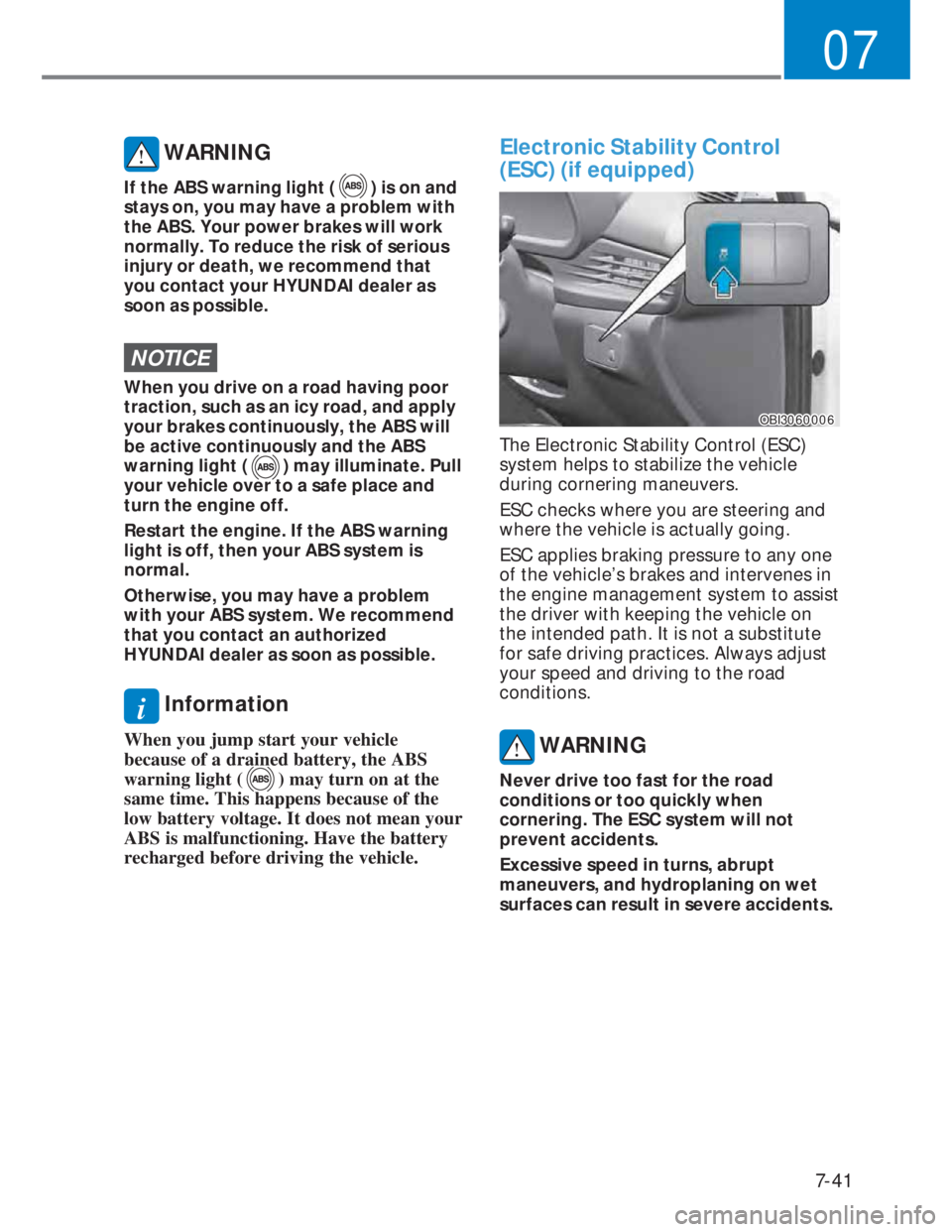
7-41
07
WARNING
If the ABS warning light () is on and
stays on, you may have a problem with
the ABS. Your power brakes will work
normally. To reduce the risk of serious
injury or death, we recommend that
you contact your HYUNDAI dealer as
soon as possible.
NOTICE
When you drive on a road having poor
traction, such as an icy road, and apply
your brakes continuously, the ABS will
be active continuously and the ABS
warning light (
) may illuminate. Pull
your vehicle over to a safe place and
turn the engine off.
Restart the engine. If the ABS warning
light is off, then your ABS system is
normal.
Otherwise, you may have a problem
with your ABS system. We recommend
that you contact an authorized
HYUNDAI dealer as soon as possible.
i Information
When you jump start your vehicle
because of a drained battery, the ABS
warning light (
) may turn on at the
same time. This happens because of the
low battery voltage. It does not mean your
ABS is malfunctioning. Have the battery
recharged before driving the vehicle.
Electronic Stability Control
(ESC) (if equipped)
OBI3060006OBI3060006
The Electronic Stability Control (ESC)
system helps to stabilize the vehicle
during cornering maneuvers.
ESC checks where you are steering and
where the vehicle is actually going.
ESC applies braking pressure to any one
of the vehicle’s brakes and intervenes in
the engine management system to assist
the driver with keeping the vehicle on
the intended path. It is not a substitute
for safe driving practices. Always adjust
your speed and driving to the road
conditions.
WARNING
Never drive too fast for the road
conditions or too quickly when
cornering. The ESC system will not
prevent accidents.
Excessive speed in turns, abrupt
maneuvers, and hydroplaning on wet
surfaces can result in severe accidents.
Page 291 of 444
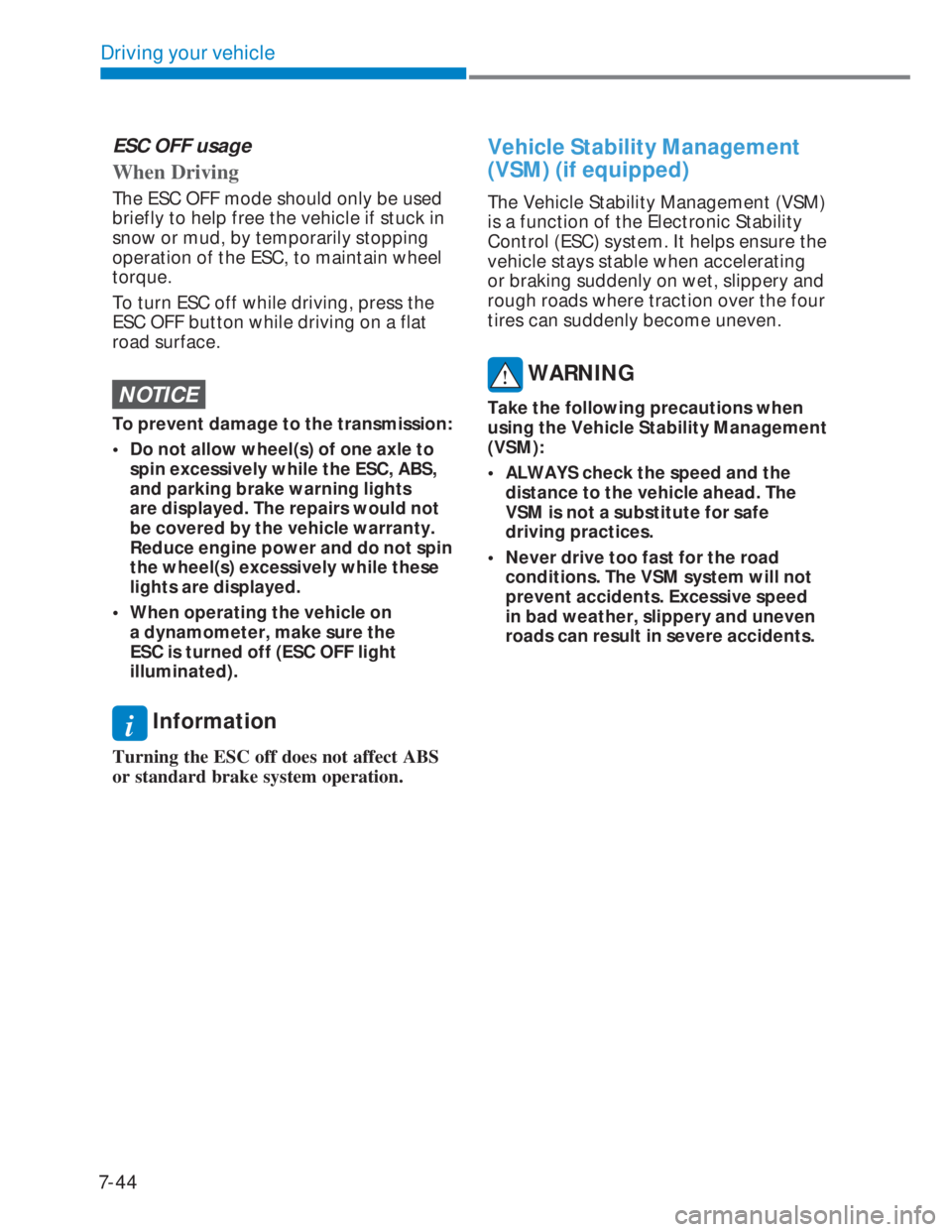
7-44
Driving your vehicle
ESC OFF usage
When Driving
The ESC OFF mode should only be used
briefly to help free the vehicle if stuck in
snow or mud, by temporarily stopping
operation of the ESC, to maintain wheel
torque.
To turn ESC off while driving, press the
ESC OFF button while driving on a flat
road surface.
NOTICE
To prevent damage to the transmission:
• Do not allow wheel(s) of one axle to
spin excessively while the ESC, ABS,
and parking brake warning lights
are displayed. The repairs would not
be covered by the vehicle warranty.
Reduce engine power and do not spin
the wheel(s) excessively while these
lights are displayed.
• When operating the vehicle on
a dynamometer, make sure the
ESC is turned off (ESC OFF light
illuminated).
i Information
Turning the ESC off does not affect ABS
or standard brake system operation.
Vehicle Stability Management
(VSM) (if equipped)
The Vehicle Stability Management (VSM)
is a function of the Electronic Stability
Control (ESC) system. It helps ensure the
vehicle stays stable when accelerating
or braking suddenly on wet, slippery and
rough roads where traction over the four
tires can suddenly become uneven.
WARNING
Take the following precautions when
using the Vehicle Stability Management
(VSM):
• ALWAYS check the speed and the
distance to the vehicle ahead. The
VSM is not a substitute for safe
driving practices.
• Never drive too fast for the road
conditions. The VSM system will not
prevent accidents. Excessive speed
in bad weather, slippery and uneven
roads can result in severe accidents.
Page 293 of 444
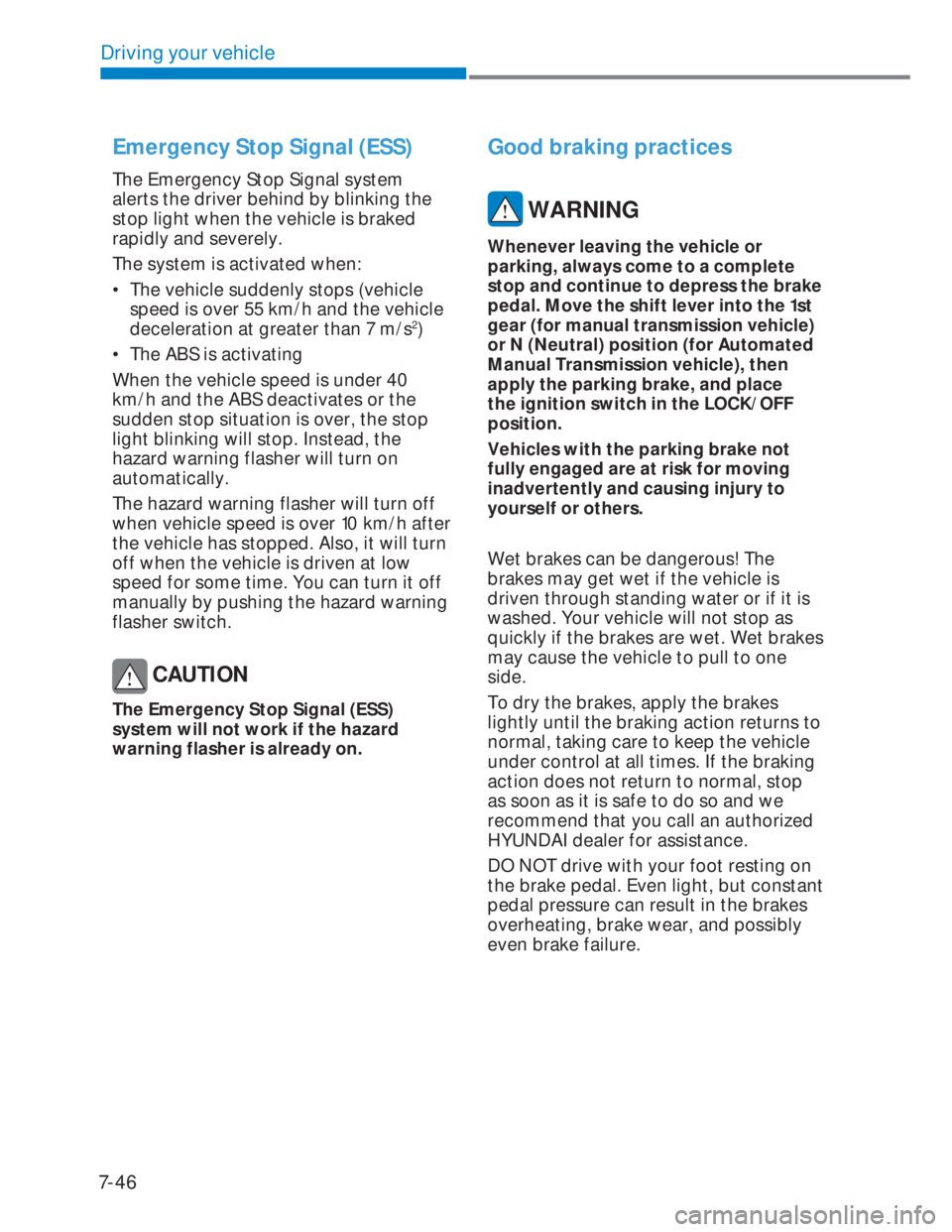
7-46
Driving your vehicle
Emergency Stop Signal (ESS)
The Emergency Stop Signal system
alerts the driver behind by blinking the
stop light when the vehicle is braked
rapidly and severely.
The system is activated when:
• The vehicle suddenly stops (vehicle
speed is over 55 km/h and the vehicle
deceleration at greater than 7 m/s
2)
• The ABS is activating
When the vehicle speed is under 40
km/h and the ABS deactivates or the
sudden stop situation is over, the stop
light blinking will stop. Instead, the
hazard warning flasher will turn on
automatically.
The hazard warning flasher will turn off
when vehicle speed is over 10 km/h after
the vehicle has stopped. Also, it will turn
off when the vehicle is driven at low
speed for some time. You can turn it off
manually by pushing the hazard warning
flasher switch.
CAUTION
The Emergency Stop Signal (ESS)
system will not work if the hazard
warning flasher is already on.
Good braking practices
WARNING
Whenever leaving the vehicle or
parking, always come to a complete
stop and continue to depress the brake
pedal. Move the shift lever into the 1st
gear (for manual transmission vehicle)
or N (Neutral) position (for Automated
Manual Transmission vehicle), then
apply the parking brake, and place
the ignition switch in the LOCK/OFF
position.
Vehicles with the parking brake not
fully engaged are at risk for moving
inadvertently and causing injury to
yourself or others.
Wet brakes can be dangerous! The
brakes may get wet if the vehicle is
driven through standing water or if it is
washed. Your vehicle will not stop as
quickly if the brakes are wet. Wet brakes
may cause the vehicle to pull to one
side.
To dry the brakes, apply the brakes
lightly until the braking action returns to
normal, taking care to keep the vehicle
under control at all times. If the braking
action does not return to normal, stop
as soon as it is safe to do so and we
recommend that you call an authorized
HYUNDAI dealer for assistance.
DO NOT drive with your foot resting on
the brake pedal. Even light, but constant
pedal pressure can result in the brakes
overheating, brake wear, and possibly
even brake failure.
Page 314 of 444
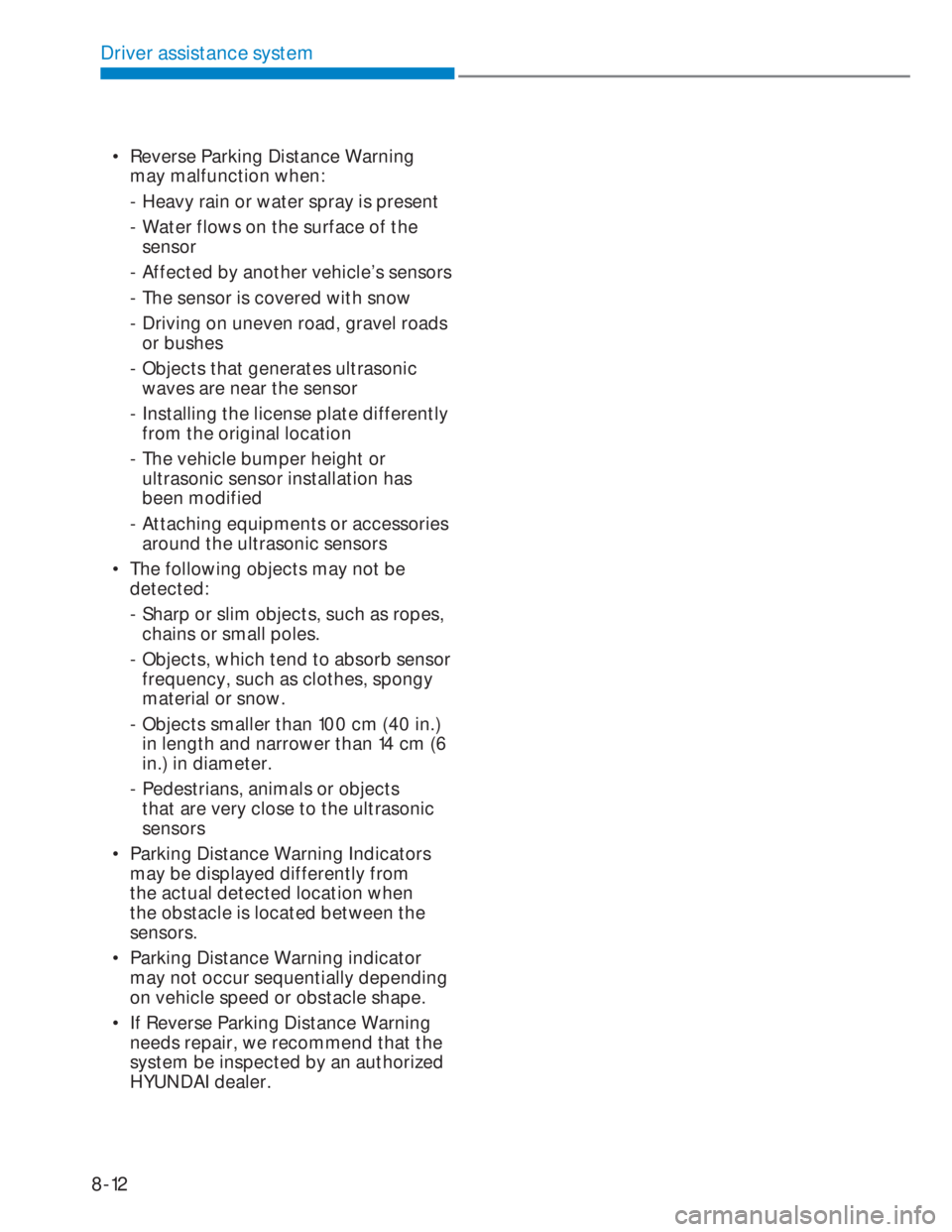
Driver assistance system
8-12
• Reverse Parking Distance Warning
may malfunction when:
- Heavy rain or water spray is present
- Water flows on the surface of the
sensor
- Affected by another vehicle’s sensors
- The sensor is covered with snow
- Driving on uneven road, gravel roads
or bushes
- Objects that generates ultrasonic
waves are near the sensor
- Installing the license plate differently
from the original location
- The vehicle bumper height or
ultrasonic sensor installation has
been modified
- Attaching equipments or accessories
around the ultrasonic sensors
• The following objects may not be
detected:
- Sharp or slim objects, such as ropes,
chains or small poles.
- Objects, which tend to absorb sensor
frequency, such as clothes, spongy
material or snow.
- Objects smaller than 100 cm (40 in.)
in length and narrower than 14 cm (6
in.) in diameter.
- Pedestrians, animals or objects
that are very close to the ultrasonic
sensors
• Parking Distance Warning Indicators
may be displayed differently from
the actual detected location when
the obstacle is located between the
sensors.
• Parking Distance Warning indicator
may not occur sequentially depending
on vehicle speed or obstacle shape.
• If Reverse Parking Distance Warning
needs repair, we recommend that the
system be inspected by an authorized
HYUNDAI dealer.